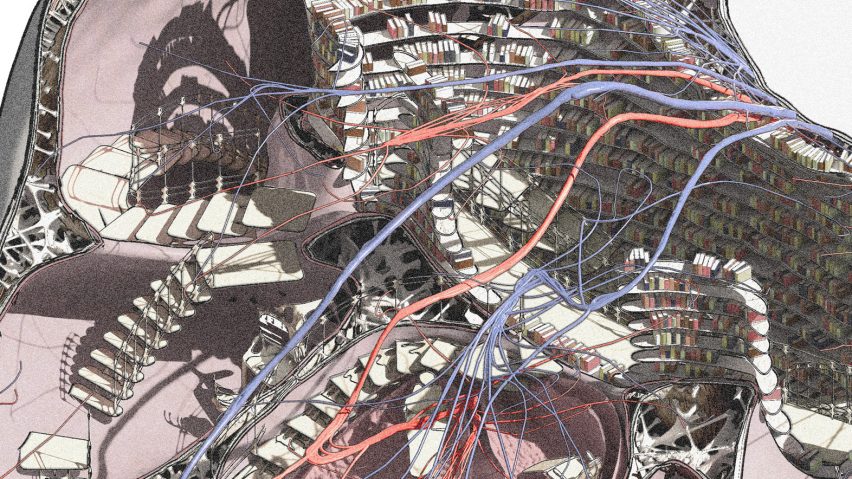
Rensselaer Polytechnic Institute presents ten architecture projects
Dezeen School Shows: a "Library of Blood" that examines society's relationship with media as an instrument of theoretical and cultural war and a modular vertical farm feature in Dezeen's latest school show by students studying architecture at Rensselaer Polytechnic Institute.
Also included is a virtual reality programme that places "virtual skins" onto existing buildings and a pavilion designed for people to experience the elements of nature.
Rensselaer Polytechnic Institute
School: School of Architecture
Tutors: Caleb White, Walaid Sehwail, Fleet Hower, Yael Erel, Stefan Svedberg, Anthony Titus, Carla Leitao, Chris Perry, Ryosuke Imaeda and Dylan Rundle.
School statement:
"Situated within one of the premier technological research universities in the US, the School of Architecture at the Rensselaer Polytechnic Institute works in collaboration with leading scientists, engineers, technologists, artists and entrepreneurs.
"Together, we reimagine the future built environment as an ecologically responsive, energy-efficient, socially conscious and poetically charged constellation of buildings and infrastructures that reinvigorate and empower diverse communities around the world.
"We believe in the benevolent power of architecture to contribute to the environmental restoration of our planet, to establish a more productive, harmonious and symbiotic relationship with the natural world and to imbue our buildings with an awe-inspiring sense of wonder and delight."
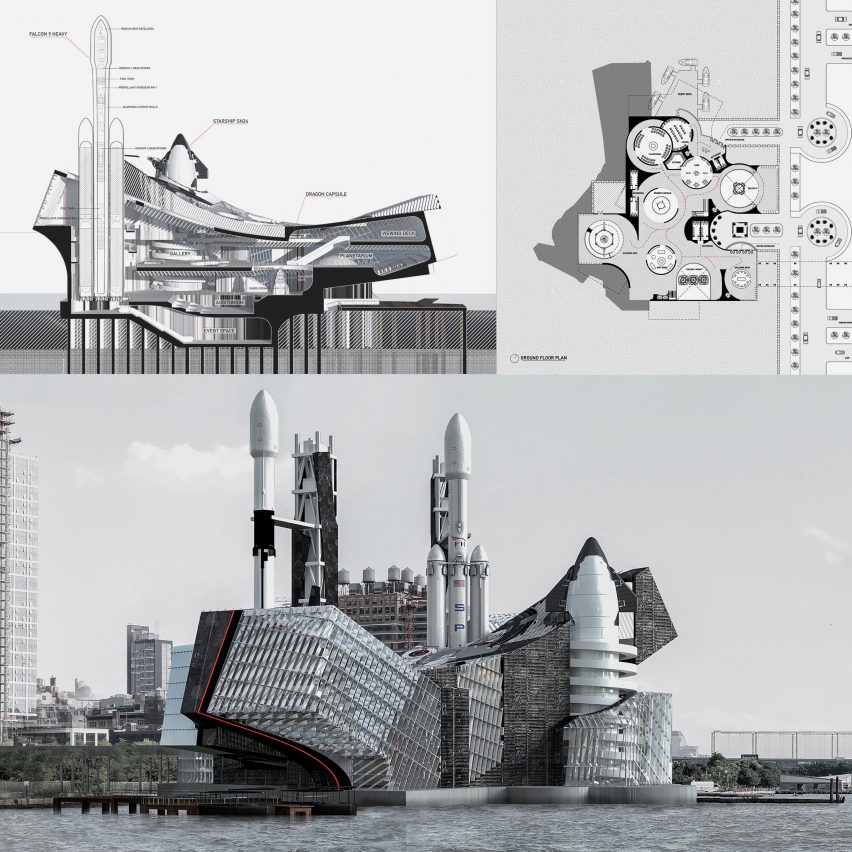
Manhattan Spaceport by Preston Kwok and Zonglin Li
"SpaceX has become the world leader in commercial spaceflight.
"By making low-earth orbit flights, passengers will be able to reach any point on Earth in 49 minutes or less, which creates the opportunity to build 'spaceports' in most major cities.
"A midtown Manhattan port on the Hudson River could provide an opportunity to accommodate passengers as they prepare for launch while also creating a branded icon for SpaceX in the city."
Students: Preston Kwok and Zonglin Li
Tutor: Caleb White
Course element: Vertical Design Studio, third, fourth and fifth year
Student emails: kwokp[at]rpi.edu and liz41[at]rpi.edu
Faculty email: whitec10[at]rpi.edu
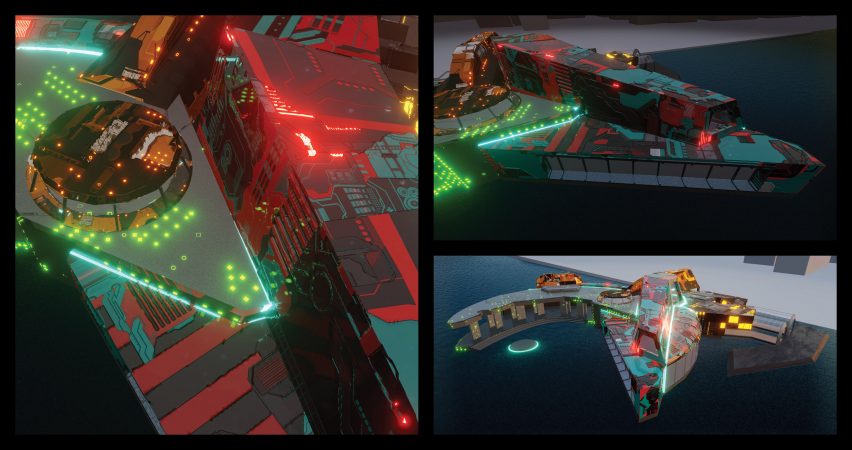
Virtual Tectonics by Daniel Cureno and Douglas Tang
"Our proposal introduces a 'virtual skin' that can be applied onto a series of physical buildings, offering visitors a gamified experience by collecting digital skins to apply to building envelopes.
"Aesthetic and conceptual inspiration is drawn from technology featured in various anime.
"The design leverages a growing interest in virtual interactions from virtual streaming through avatar-based VTubers and digital collectables found in popular games, to construct a physically tied virtual experience bringing the digital to the real, and vice versa."
Students: Daniel Cureno and Douglas Tang
Tutor: Walaid Sehwail
Course element: Vertical Design Studio, third, fourth and fifth year
Student emails: curend[at]rpi.edu and tangd2[at]rpi.edu
Faculty email: sehwaw[at]rpi.edu
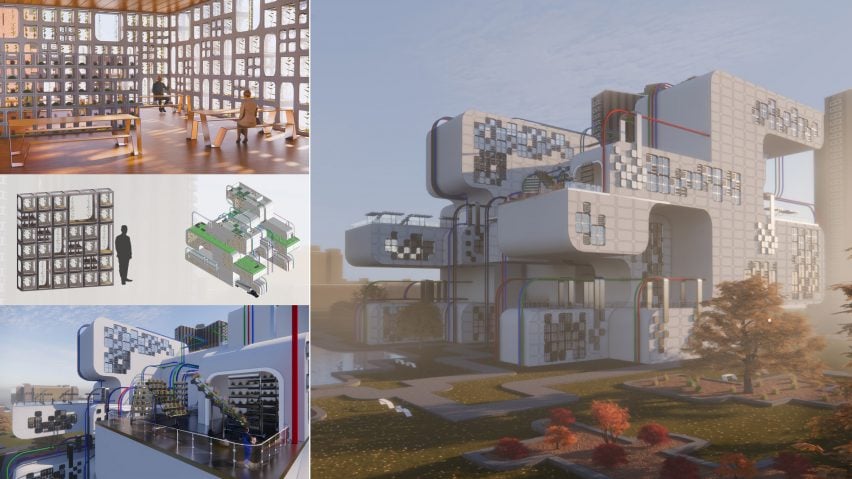
Cultivate by Megumi Call and Tommy Giordano
"Cultivate is a multi-use center in Co-op City that cultivates crops, commerce and community through a modular design that addresses economy of scale.
"With 110,000 square feet of vertical farms, Cultivate tackles Co-op City's food crisis through its dining and retail spaces, which stimulate commerce in this predominantly residential area, and dedicated workspaces that provide the community with accessible educational resources.
"The building's functions must first support the farms for Cultivate to support Co-op City. Much of the structure and MEP functions – elements traditionally hidden from view – are brought to the forefront and celebrated.
"From interlocking plant pods to modular program units, Cultivate is a sustainable and scalable response to the multifaceted needs of Co-op City."
Students: Megumi Call and Tommy Giordano
Tutor: Fleet Hower
Course: Vertical Design Studio, third, fourth, fifth-year
Student emails: callm[at]rpi.edu and giordt[at]rpi.edu
Faculty email: howerj[at]rpi.edu
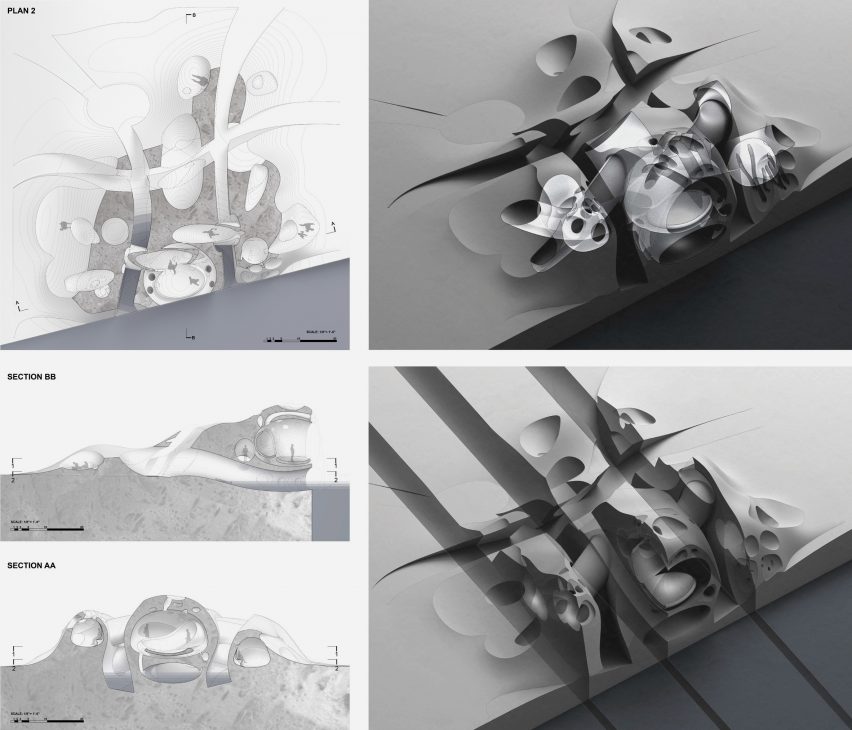
Observation Machine: Energy of Elements by Javier Torres
"Light and sound are similar forms of energy.
"Both waves can be transmitted, reflected, refracted and absorbed. The Observation Machine: Energy of Elements pavilion operates as a device to perceive and augment natural elements, paying close attention to how they can be orchestrated and combined through architecture.
"Situated with access to sunlight, water and wind, this pavilion is a tool that produces visual and audible experiments.
"The experiments are conducted in three separate rooms, each dedicated to a single element: light, water and sound, and one large space that observes the experience that unfolds as these elements are combined."
Student: Javier Torres
Tutor: Yael Erel
Course element: Architectural Design 2, first year
Student email: torrej8[at]rpi.edu
Faculty email: erely2[at]rpi.edu
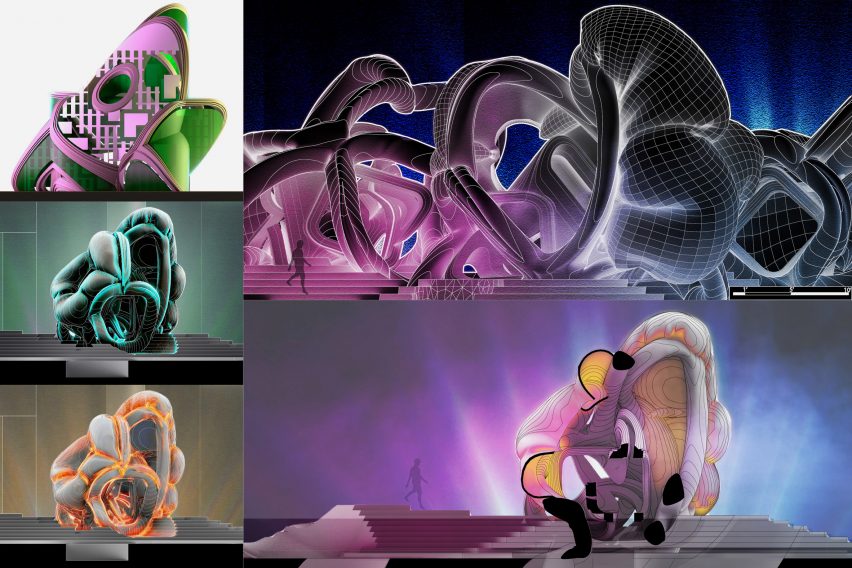
Luminous by Shawn Putman
"This project explores the syntax of multiple correlated and uncorrelated architectural expressions to create hybrid assemblages, taking the form of a pavilion situated on Troy's downtown riverfront.
"The project targets the juxtaposition and/or synthesis of dissimilar characteristics through the interrogation and subversion of various design expressions – from the sweeping arches, framing and organisational strategies of classical architecture to the simulated geometries and ephemeral effects of computational design.
"Luminous is a hybrid configuration of architectural frames, inflated membranes and illuminated effects.
"The project envisions the built environment as an arena with multiple – sometimes even contradictory – readings that come together to form composite narratives about place and time."
Student: Shawn Putman
Tutor: Stefan Svedberg
Course element: Architectural Design 2, first year
Student email: putmas[at]rpi.edu
Faculty email: svedbp[at]rpi.edu
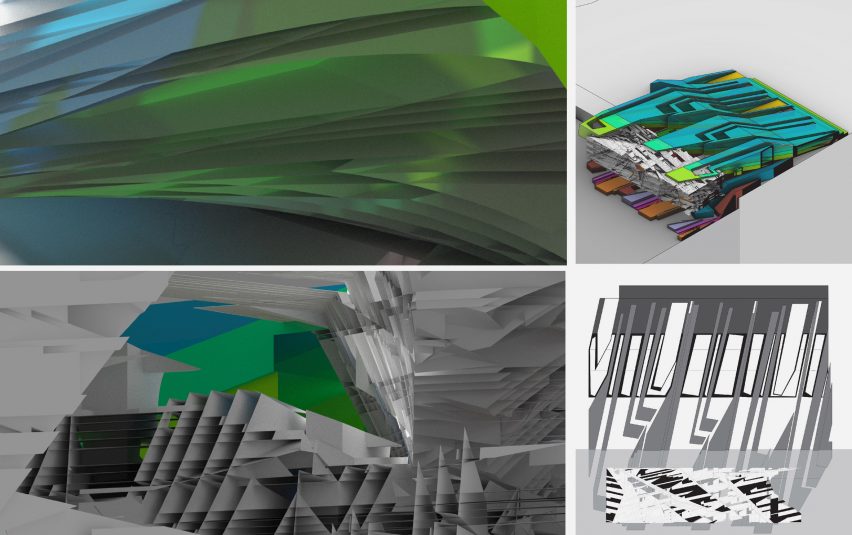
Gesticular Hiatus by Kyra Gregoire
"This project tasked the students with designing a pavilion informed by the colour patterns of the Japanese artist Takahiro Kurashima.
"Gesticular Hiatus serves as a social space and sanctuary to be situated along the edge of the Hudson River in Troy, New York.
"The sweeping arm allows unique access into the pavilion, creating a moment of a pause due to the solid white surroundings.
"Light washes into the upper levels of the space allowing inhabitants to experience a heightened sense of geometry, form, color and the surrounding environment."
Student: Kyra Gregoire
Tutor: Anthony Titus
Course element: Architectural Design 2, first year
Student email: gregok4[at]rpi.edu
Faculty email: at[at]anthony-titus.com
Lucid Urbania by Becky Zhang
"This thesis explores the possible future of collaboration between humans and AI.
"Lucid Urbania is a hybridisation of the immersive and physical realms that become the starting point for collaboration between humans and artificial intelligence.
"The scheme is made up of three islands, destined to expand by constant regeneration.
"Through the process of replication and extraction of data, islands are formed from the input of virtual artifacts generated by machine learning algorithms to incorporate the essential elements of human intelligence in the future of rapidly growing artificial intelligence.
"A tectonic language of pixelisation and glitch flows throughout the islands, representing the ever-shifting intelligent collective that is reconstructing reality impermanently."
Student: Becky Zhang
Tutor: Carla Leitao
Course element: Final Project, fifth year thesis
Student email: beckyzhang808[at]gmail.com
Faculty email: leitac[at]rpi.edu
Ostranenie: Architecture's Estrangement by Emily Durso
"Ostranenie: Architecture's Estrangement explores an approach to aesthetic practice that establishes architectural drawing, film sets and theatrical props as sites of experimentation.
"The medium of film brings these various scales of representation together into a visual narrative for engaging broader questions of dwelling, with the building typology of the hotel situated as a programmatic condition of transience associated with the ecological uncanny's implicit ambiguity and estrangement.
"In addition to engaging such conditions of estrangement at the scale of dwelling, the proposal can be understood as a defamiliarisation of traditional disciplinary identity; a form of homelessness situated somewhere between architecture, theater and film – a transdisciplinary condition characterised by the same qualities of estrangement that define our current moment of environmental uncertainty."
Student: Emily Durso
Tutor: Chris Perry
Course element: Final Project, fifth year thesis
Student email: [email protected]
Faculty email: perryc3[at]rpi.edu
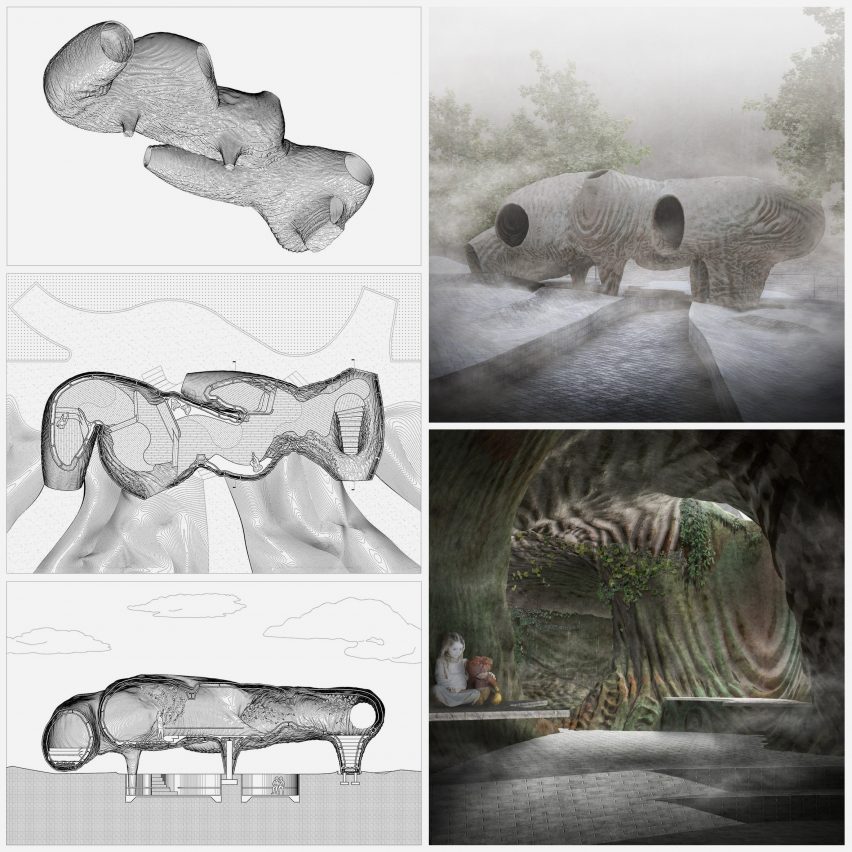
Living with the Unknown by Jillian Lin
"As most architecture today is created to contain something within, the goal of this project is to bring the focus back to the building itself.
"Situated near a farmer's market in Troy, this building induces an uncomfortable and yet warm feeling through its wrinkled facade.
"The oddly posed structure against the vibrant market yields a juvenile curiosity, gravitating individuals to explore the wrinkles.
"The uncertainty of their firmness, color and senility moves visitors close to the building and towards the entrances.
"The internal circulation winds continuously to guide a search for spaces defined by the expressions of the wrinkles at particular angles."
Student: Jillian Lin
Tutor: Ryosuke Imaeda
Course element: Architectural Design 2, first year
Student email: linj22[at]rpi.edu
Faculty email: imaedr[at]rpi.edu
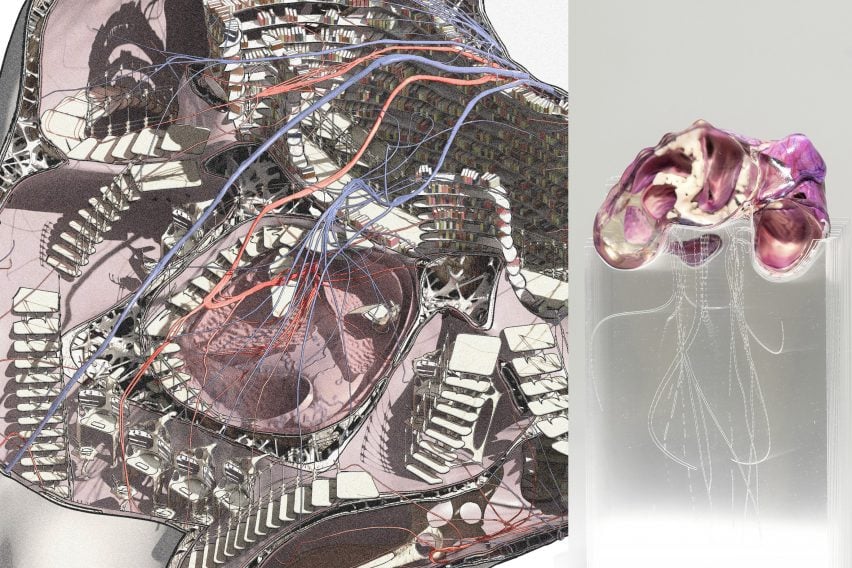
Hemotheque by Dylan Rundle
"The Hemotheque, or the Library of Blood, by Dylan Rundle re-examines society's interrelationships with media and knowledge as an instrument of theoretical, cultural and physical war.
"The Hemotheque is an autonomous hive that pollinates physical, digital and experiential media across social divides and the echo-chambers of the internet."
"This thesis project revisits the monolithicity and centralized authority of civic institutions by proposing new typologies of civic architecture that consider the built environment as both a tectonic assemblage of materials and an ecosystem of technologies – interweaving people, information and ecologies through networks, the cloud, analytics and artificial intelligence.
"The project asks how new forms of biological to technological interfaces can redefine disciplinary expectations and relationships, examining how emerging technologies and immersive media can ultimately reshape the physical subtrata of the civic or public realm.
Student: Dylan Rundle
Tutor: Hseng Lintner
Course element: Final Project, fifth year thesis
Student email: lintnh[at]rpi.edu
Faculty email: dylanbrundle[at]gmail.com
Partnership content
This school show is a partnership between Dezeen and Rensselaer Polytechnic Institute. Find out more about Dezeen partnership content here.